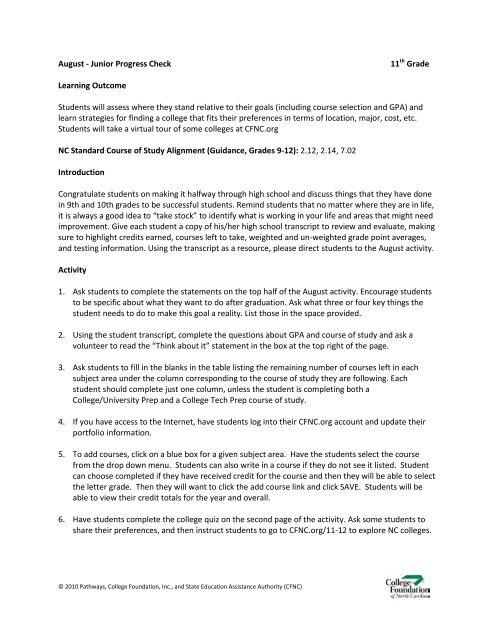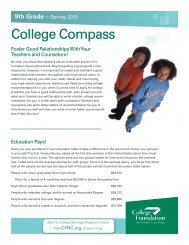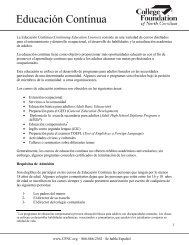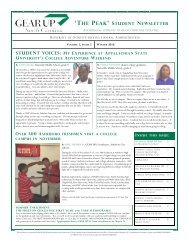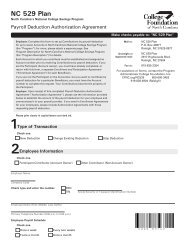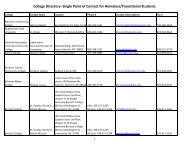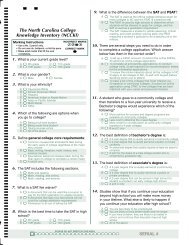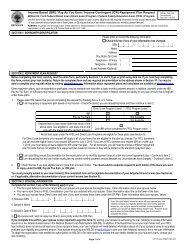August - Junior Progress Check 11th Grade Learning Outcome ...
August - Junior Progress Check 11th Grade Learning Outcome ...
August - Junior Progress Check 11th Grade Learning Outcome ...
You also want an ePaper? Increase the reach of your titles
YUMPU automatically turns print PDFs into web optimized ePapers that Google loves.
<strong>August</strong> - <strong>Junior</strong> <strong>Progress</strong> <strong>Check</strong><br />
11 th <strong>Grade</strong><br />
<strong>Learning</strong> <strong>Outcome</strong><br />
Students will assess where they stand relative to their goals (including course selection and GPA) and<br />
learn strategies for finding a college that fits their preferences in terms of location, major, cost, etc.<br />
Students will take a virtual tour of some colleges at CFNC.org<br />
NC Standard Course of Study Alignment (Guidance, <strong>Grade</strong>s 9-12): 2.12, 2.14, 7.02<br />
Introduction<br />
Congratulate students on making it halfway through high school and discuss things that they have done<br />
in 9th and 10th grades to be successful students. Remind students that no matter where they are in life,<br />
it is always a good idea to “take stock” to identify what is working in your life and areas that might need<br />
improvement. Give each student a copy of his/her high school transcript to review and evaluate, making<br />
sure to highlight credits earned, courses left to take, weighted and un-weighted grade point averages,<br />
and testing information. Using the transcript as a resource, please direct students to the <strong>August</strong> activity.<br />
Activity<br />
1. Ask students to complete the statements on the top half of the <strong>August</strong> activity. Encourage students<br />
to be specific about what they want to do after graduation. Ask what three or four key things the<br />
student needs to do to make this goal a reality. List those in the space provided.<br />
2. Using the student transcript, complete the questions about GPA and course of study and ask a<br />
volunteer to read the “Think about it” statement in the box at the top right of the page.<br />
3. Ask students to fill in the blanks in the table listing the remaining number of courses left in each<br />
subject area under the column corresponding to the course of study they are following. Each<br />
student should complete just one column, unless the student is completing both a<br />
College/University Prep and a College Tech Prep course of study.<br />
4. If you have access to the Internet, have students log into their CFNC.org account and update their<br />
portfolio information.<br />
5. To add courses, click on a blue box for a given subject area. Have the students select the course<br />
from the drop down menu. Students can also write in a course if they do not see it listed. Student<br />
can choose completed if they have received credit for the course and then they will be able to select<br />
the letter grade. Then they will want to click the add course link and click SAVE. Students will be<br />
able to view their credit totals for the year and overall.<br />
6. Have students complete the college quiz on the second page of the activity. Ask some students to<br />
share their preferences, and then instruct students to go to CFNC.org/11-12 to explore NC colleges.<br />
© 2010 Pathways, College Foundation, Inc., and State Education Assistance Authority (CFNC)
Wrap Up<br />
Have students write a note or send an email to their counselor requesting a meeting to discuss at least<br />
two of the colleges that matched their requirements. Have students visit the college center in the<br />
counseling office (during non-class time) to get more information about the schools they’ve explored<br />
today, or visit CFNC.org/11-12 for a link to virtual tours of colleges of interest. The school counseling<br />
office often has publications and CDs produced by the colleges.<br />
© 2010 Pathways, College Foundation, Inc., and State Education Assistance Authority (CFNC)
September – College Entrance Tests<br />
11 th <strong>Grade</strong><br />
<strong>Learning</strong> <strong>Outcome</strong><br />
Students will learn about the different types of college entrance tests (SAT, ACT, ASSET, COMPASS, and<br />
ACUPLACER), when to take them, and how to prepare for them.<br />
NC Standard Course of Study Alignment (Guidance, <strong>Grade</strong>s 9-12): 2.08, 3.06, 5.10<br />
Introduction<br />
Invite students to discuss things that they know or have heard about college entrance tests. Take a few<br />
minutes to make a list on the board with comments the students make about entrance tests. (What are<br />
the names of these tests? Who should take them? How many times? Is it expensive? Where do they give<br />
these tests?) Ask students to identify the sources of any information they have acquired about these<br />
tests (friends, siblings, parents, teachers, Internet, etc.)<br />
Activity<br />
1. Ask students to answer the sample test questions in the activity for September. <strong>Check</strong> those<br />
questions with the answers on the second page. Ask students if they feel prepared to take an<br />
entrance test today based on that activity. Explain that most of the time, we feel better prepared to<br />
manage any task (a test, a job interview, a basketball tryout) the more that we know about that<br />
particular task. Tell them that today, they will learn more about college entrance tests to gain<br />
confidence and understanding about these tests and the process.<br />
2. Have a volunteer read the SAT description on the first page. See if anything in that paragraph<br />
matches what the students mentioned in the list you put on the board.<br />
3. Ask another volunteer to read the ACT description on page 1 and another to read the placement<br />
test descriptions on page 2. Again, check these against the list you made during the introduction.<br />
You may simply circle anything that is true based on the information presented.<br />
4. If you have a computer and Internet access, direct students to CFNC.org/PS to find the publication<br />
entitled College Entrance Tests so they can locate additional resources. If possible, have a copy of<br />
this brochure for each of the students.<br />
5. Explain that preparation for testing is the key to success. Have students log into their CFNC account<br />
and direct them to College Test Prep where they will find resources for the SAT, ACT, and Vocab<br />
Builder interactive test prep activities. Reiterate the point that preparation is crucial to achieving the<br />
best score with these tests. Mention that there may be free paper study materials for both the SAT<br />
and the ACT in your school’s counseling center.<br />
© 2010 Pathways, College Foundation, Inc., and State Education Assistance Authority (CFNC)
6. Ask students to explain who needs to take a college entrance test. Using the information at<br />
CFNC.org, ask students to find out which test is required at the colleges they are interested in and<br />
write that information in the activity. Using the testing calendar information on page 2, have<br />
students highlight the test dates best for them and note the registration deadline. Students should<br />
take the PSAT in October as practice for the SAT and for participation in the National Merit<br />
Scholarship search.<br />
7. Remind students that while the SAT and ACT are not required for admission at most community<br />
colleges, students going to community colleges will be asked to take a placement test, like ASSET or<br />
COMPASS, to identify the appropriate college-level math and English courses they should take.<br />
Wrap Up<br />
Have students outline a brief college entrance exam prep plan on a 4x6 index card:<br />
1. Which test should I take?<br />
2. When is it given?<br />
3. Deadline for registration?<br />
4. How will I prepare?<br />
Have students share this information with a parent or other important adult.<br />
© 2010 Pathways, College Foundation, Inc., and State Education Assistance Authority (CFNC)
October – Your <strong>Learning</strong> Style<br />
11 th <strong>Grade</strong><br />
<strong>Learning</strong> <strong>Outcome</strong><br />
Students will gain awareness of their personal learning style by taking the <strong>Learning</strong> Style Inventory at<br />
CFNC.org and plan study strategies that work best for them.<br />
NC Standard course of Study Alignment (Guidance, <strong>Grade</strong>s 9-12): 1.09, 2.06<br />
Introduction<br />
Tell students that in the same manner that we all look differently and have different ideas, each of us<br />
learns in a different way. Let them know that understanding your personal learning style is an important<br />
step in developing an appropriate study plan for this year and for the years to come. Finding your<br />
learning style is like finding the perfect fitting shoe – you can’t put a size 13 foot in a size 9 shoe!<br />
Activity<br />
1. Ask students to complete the brief survey of learning styles in the October activity. Students should<br />
put a check mark in the box that is most true for them.<br />
2. Ask students to review their answers to compare them to what happens in their everyday life. Ask,<br />
“Are you matching your learning style or working against what works best for you? Are there some<br />
adjustments you need to make? Jot those down.”<br />
3. Have students answer the remaining fill-in-the-blank statements on the activity. Ask volunteers to<br />
share how they usually prepare for tests and how they manage daily homework assignments.<br />
4. If you have computer and Internet access, have students log on to CFNC.org/11-12. Have students<br />
follow the link and log in to CFNC.org to take the <strong>Learning</strong> Style Inventory. Students can complete<br />
the <strong>Learning</strong> Style Inventory (LSI) in about 20 minutes.<br />
5. If possible, have students print the results from the LSI and use those results to respond to the<br />
activity questions on page 2 of the activity.<br />
6. After students complete the last two questions on the activity, have them use the statements from<br />
the report to develop “personal study plans” for 11 th grade.<br />
Wrap Up<br />
Based on what they have learned about themselves, ask students to list five strategies that they should<br />
use to prepare for their next semester exam, or a college entrance test. Have each student share a<br />
strategy with the group.<br />
IMPORTANT: Significant navigational changes to CFNC.org are expected in 2009-10. Use of the landing<br />
page (CFNC.org/MS) for completion of these activities will make it easier to find needed resources.<br />
© 2009 Pathways, College Foundation, Inc., and State Education Assistance Authority (CFNC)
November – Managing Your Money<br />
11 th <strong>Grade</strong><br />
<strong>Learning</strong> <strong>Outcome</strong><br />
Students will learn strategies for managing money, how to create a budget, and tips for planning<br />
financially for college.<br />
NC Standard Course of Study Alignment (Guidance, <strong>Grade</strong>s 9-12): 4.05, 4.07, 7.02, 8.09<br />
Introduction<br />
Managing money is a very useful skill, and practicing managing money now (even if you don’t have<br />
much to manage) can make you a better money manager in the future. The average college graduate<br />
leaves college for the “real world” with $4,000 in credit card debt and $18,000 in college loans to repay.<br />
Let’s take steps now to avoid some of that debt!<br />
Activity<br />
1. Have you ever wondered where your money goes? The best way to answer that question is to keep<br />
a running list of expenditures. Begin to fill in the expected income/expenses spaces in your activity<br />
listing sources of income and projected expenses for the month. Add up the totals – this is your<br />
projected budget.<br />
2. Read the Smart Money Management Tips on the second page of this activity. In small groups,<br />
students should brainstorm ideas for earning money and for saving money.<br />
3. Have students go to CFNC.org/11-12 to listen to a short podcast about money, in which college<br />
students offer tips on managing money based on their experiences – good and bad!<br />
4. Students can also find fact sheets on CFNC.org/11-12 for more information on creating good<br />
spending habits and creating a budget.<br />
5. Return to the activity and ask students to track actual expenses in the spaces given for the next<br />
month. Remind them, “Don’t forget to include the soda you bought at lunch!” Have them set a date<br />
to revisit this activity next month to check out their spending habits.<br />
Wrap Up<br />
Have students write a short paragraph identifying possible future purchases for which they will need to<br />
save. What might they need to save for in the next two years? Next 10 years? How can a budget help<br />
them save money for these things?<br />
Introduce them to the Financial Literacy 101 course on CFNC.org under the PAY tab. Point out that they<br />
can take this course and it will keep track of their progress (allowing for stopping and starting). Note the<br />
resources link and the calculators. Assign modules as homework or encourage them to do the course on<br />
their own.<br />
IMPORTANT: Significant navigational changes to CFNC.org are expected in 2009-10. Use of the landing<br />
page (CFNC.org/MS) for completion of these activities will make it easier to find needed resources.<br />
© 2009 Pathways, College Foundation, Inc., and State Education Assistance Authority (CFNC)
December – Finding Scholarships<br />
11 th <strong>Grade</strong><br />
<strong>Learning</strong> <strong>Outcome</strong><br />
Students will learn about the different sources of scholarships, where to find scholarships, and how to<br />
do a scholarship search at CFNC.org. Students will gain awareness of the other ways to pay for college<br />
including grants, work, savings, payments plans, and loans.<br />
NC Standard course of Study Alignment (Guidance, <strong>Grade</strong>s 9-12): 2.04, 8.12<br />
Introduction<br />
Ask students “Have you ever heard of anyone receiving a ‘full ride’ to attend a certain college? Do you<br />
have any idea what that means? How do you think that most people pay for the expense of a college<br />
education?” Tell students that each year, students from this high school and every high school across<br />
North Carolina are awarded scholarship money to help pay for college expenses. Scholarship money is<br />
desired because it is free and you don’t have to pay it back. Students who are looking for money to go to<br />
college can start looking at scholarship programs now in order to be prepared to be competitive for<br />
receiving them as seniors. Ask, “Besides scholarships, what other types of aid are available to help pay<br />
for college? Where should you get started?”<br />
Activity<br />
1. Ask students to read the information on the December activity. They should take a minute to<br />
highlight important pieces of information.<br />
2. Remind students that when looking for scholarship opportunities, start with local and school<br />
opportunities, then widen the search to include regional, state, and national scholarship<br />
opportunities. Local scholarships probably have the least number of students competing for the<br />
money, while the largest national scholarships might have a huge number of applicants.<br />
3. Give a copy of your school’s scholarship update (ask your scholarship counselor) to each student.<br />
Have students circle any scholarships for which they might be qualified.<br />
4. To broaden the search, if you have Internet access, ask students to log on to CFNC.org and find<br />
information on paying for college. CFNC.org has information on scholarships and grants as well as<br />
low interest loans and savings programs.<br />
5. Discuss the scholarship options at CFNC.org and any that your school might be aware of. Define<br />
need-based and merit-based scholarships. Have students complete the chart in the activity.<br />
6. Review the info in the box, “Ways to Pay for College” by discussing each option. Students and<br />
parents can learn more by reading the “How Do I Pay for College?” brochure available at CFNC.org<br />
/PS, or by calling 1-866-866-CFNC to order copies in advance for this lesson.<br />
IMPORTANT: Significant navigational changes to CFNC.org are expected in 2009-10. Use of the landing<br />
page (CFNC.org/MS) for completion of these activities will make it easier to find needed resources.<br />
© 2009 Pathways, College Foundation, Inc., and State Education Assistance Authority (CFNC)
Wrap Up<br />
Ask students to note any scholarships related to specific majors or careers and to name some of those<br />
found today. Remind students that each college also offers a number of scholarship opportunities to<br />
potential students and ask each student to find a scholarship opportunity found at a North Carolina<br />
school of interest to them, recording that on their activity, as well.<br />
IMPORTANT: Significant navigational changes to CFNC.org are expected in 2009-10. Use of the landing<br />
page (CFNC.org/MS) for completion of these activities will make it easier to find needed resources.<br />
© 2009 Pathways, College Foundation, Inc., and State Education Assistance Authority (CFNC)
January – Your Personality<br />
11 th <strong>Grade</strong><br />
<strong>Learning</strong> <strong>Outcome</strong><br />
Students will learn more about their own personality and others when they take a personality<br />
assessment called Do What You Are (based on Myers-Briggs) at CFNC.org. Students will also understand<br />
how personality influences career choice.<br />
NC Standard Course of Study Alignment (Guidance, <strong>Grade</strong>s 9-12): 2.09, 5.02, 6.03, 7.10, 7.15<br />
Introduction<br />
Ask students to think of three words to describe their personality. Explain to students that their<br />
personality is unique to them and that research suggests that people who pick careers that compliment<br />
their personality and interests tend to be more satisfied. Personality traits play an important role in<br />
helping students understand their personal educational and career needs. Tell students, “Let’s take a<br />
look at our personality types to get information about careers that make the most of who we are. Does<br />
doing what you are make sense to you?”<br />
Activity<br />
1. Have students respond to the four personality type questions in the January activity. Have them<br />
read the questions and circle the response that best fits.<br />
2. Ask students to record each circled letter from the four questions answered and add to the first<br />
personality code spaces: _____ ______ ______ ______<br />
3. If you have Internet access, direct students to CFNC.org/11-12 to begin the personality inventory, Do<br />
What You Are, which will take about 15 minutes.<br />
4. Have students record the four-letter personality code from Do What You Are (DWYA) in the spaces<br />
provided in their activity. Compare this code to the first code they recorded. Have students circle<br />
letter matches in both codes. The second assessment was more thorough and should provide more<br />
useful results than the first.<br />
5. Ask students to take some time to look at the possible career matches based on their responses that<br />
are outlined in the DWYA report. If they are able to print reports, have them highlight or circle<br />
careers of interest for them.<br />
6. Ask students how their personality preferences might affect them in a workplace setting. Have<br />
students work in pairs according to their trait and tell each pair to list strengths/challenges in their<br />
activity. After five minutes, have each pair discuss their ideas with the entire group.<br />
IMPORTANT: Significant navigational changes to CFNC.org are expected in 2009-10. Use of the landing<br />
page (CFNC.org/MS) for completion of these activities will make it easier to find needed resources.<br />
© 2009 Pathways, College Foundation, Inc., and State Education Assistance Authority (CFNC)
Wrap Up<br />
Brainstorm personality traits of a few well-known people (i.e. Donald Trump, Oprah Winfrey, Simon<br />
Cowell, etc.) and discuss what it is about their personality that makes them a great match for their<br />
chosen career. Ask students to identify someone they know who has made a good connection with<br />
personality traits to a career (could be a teacher, administrator, parent, sibling, etc.).<br />
IMPORTANT: Significant navigational changes to CFNC.org are expected in 2009-10. Use of the landing<br />
page (CFNC.org/MS) for completion of these activities will make it easier to find needed resources.<br />
© 2009 Pathways, College Foundation, Inc., and State Education Assistance Authority (CFNC)
February – Your Work Values<br />
11 th <strong>Grade</strong><br />
<strong>Learning</strong> <strong>Outcome</strong><br />
Students will understand how personal values relate to career selection using the Work Values Sorter at<br />
CFNC.org.<br />
NC Standard course of Study Alignment (Guidance, <strong>Grade</strong>s 9-12): 2.09, 4.03, 7.02<br />
Introduction<br />
According to Webster’s Dictionary, a value is “something (as a principle or quality) intrinsically valuable<br />
or desirable.” All of us develop personal value systems that drive our decision-making and life choices.<br />
Tell students to “Take a minute to think about some of your beliefs and attitudes about life, family, and<br />
school. Just as we have life values, we also develop work values that become an important consideration<br />
in choosing a career. Let’s see what your work values look like.”<br />
Activity<br />
1. Ask student to rate the statements in the activity using the scale (1=Least Important to 4=Most<br />
Important) and circle their responses.<br />
2. When finished, have students tally how many points they circled for each category. Ask students,<br />
“Based on those tallies, which work values seemed most important to you? Write those in the<br />
spaces provided in the activity.”<br />
3. Have students discuss how work values relate to last month’s activity on their personality. Do they<br />
see connections between their personality and their work values?<br />
4. If you have Internet access, prompt students to go to CFNC.org/11-12 to take the actual Work<br />
Values Sorter interactive assessment, which should take about 10 minutes. Those results will further<br />
define the work values from the activity and will match careers to their work values.<br />
Wrap Up<br />
Have students identify three careers that match with their personal work values. Poll the class for<br />
students who are currently working, or have worked a job in the past, and ask them to compare current<br />
or former jobs to their work values. Do they match? Have working students share their “real world”<br />
experiences with the class.<br />
IMPORTANT: Significant navigational changes to CFNC.org are expected in 2009-10. Use of the landing<br />
page (CFNC.org/MS) for completion of these activities will make it easier to find needed resources.<br />
© 2009 Pathways, College Foundation, Inc., and State Education Assistance Authority (CFNC)
March – Who Would You Admit?<br />
11 th <strong>Grade</strong><br />
<strong>Learning</strong> <strong>Outcome</strong><br />
Students will learn more about the college admissions process, reviewing mock student profiles and<br />
deciding who to admit and why.<br />
NC Standard Course of Study Alignment (Guidance, <strong>Grade</strong>s 9-12): 2.02, 2.14, 3.06<br />
Introduction<br />
Have you ever wondered how students are selected for admissions to North Carolina colleges and<br />
universities? What are admissions counselors looking for in an applicant and how can they make<br />
decisions based on an application without ever meeting the person? While making decisions for the fall<br />
2007 freshman class, the University of North Carolina at Chapel Hill reviewed 20,064 applications and<br />
eventually admitted 6,993 students. That’s a lot of applications being reviewed! How does one applicant<br />
stand out from another and make the list? Tell students that today, they will take a turn as college<br />
admissions counselors and develop criteria to select the students who fit best at their college.<br />
Activity<br />
1. Have students read the activity description in their activity. Identify and list on the board criteria<br />
that colleges use to review applications.<br />
2. In small groups, ask students to complete the admissions activity by working together to select two<br />
students for admission from the three profiles described in the activity.<br />
3. Ask each group to present their selections for admission, as well as the student denied admission,<br />
with a rationale for all. Tally the results and discuss whether this was an easy or difficult task for the<br />
groups.<br />
4. Ask what other types of information they would have liked to have known about the candidates and<br />
ask students to record that in the space provided.<br />
5. If you have Internet access, ask students to go to CFNC.org/11-12 to gather information about the<br />
admissions (look for that link) selection process from two different North Carolina colleges. Ask,<br />
“Are you on track?”<br />
Wrap Up<br />
Ask students, “How does completing this activity help you prepare for the college application process<br />
next year? What factors will colleges consider when they review your college application?” Download<br />
more copies of “Writing Your Admissions Essay”, at CFNC.org/PS. Have students write a journal entry in<br />
their portfolio on CFNC.org reflecting on what they learned today.<br />
IMPORTANT: Significant navigational changes to CFNC.org are expected in 2009-10. Use of the landing<br />
page (CFNC.org/MS) for completion of these activities will make it easier to find needed resources.<br />
© 2009 Pathways, College Foundation, Inc., and State Education Assistance Authority (CFNC)
April – Your Abilities<br />
11 th <strong>Grade</strong><br />
<strong>Learning</strong> <strong>Outcome</strong><br />
Students will make the connection between their abilities and career options when they take the Ability<br />
Profiler at CFNC.org.<br />
NC Standard Course of Study Alignment (Guidance, <strong>Grade</strong>s 9-12): 2.09, 4.03, 5.02, 6.08<br />
Introduction<br />
Ask students to take a minute to think about things that come easily to them (solving a math problem,<br />
creating a poster, putting things together, communicating with others, etc.). Remind students that as we<br />
all have individual interests and values, we also have individual abilities; what one is “good at” is an<br />
important consideration in exploring career choices.<br />
Activity<br />
1. Ask students to read the paragraphs from the April activity. Ask volunteers to help interpret the bar<br />
graph at the top corner of this page. Discuss the six different abilities examined in this assessment<br />
and ask students for an example of each.<br />
2. Give students five minutes to answer the Ability Profiler sample questions featured in the April<br />
activity. Afterwards, check their responses with the answers on the bottom of the right page. Which<br />
questions were the easiest to answer? Which were the most difficult?<br />
3. If you have Internet access and 60-90 minutes, direct students to the online Ability Profiler at<br />
CFNC.org/11-12. (Note: Students can resume the Ability Profiler where they left off if there is not<br />
enough time to finish all assessments in one class.)<br />
4. When students complete the Ability Profiler, ask them to record ability levels (top 10%, average,<br />
etc.) in the spaces provided in the activity.<br />
5. Review the Careers List generated from the Ability Profiler activity. If possible, have students print<br />
this report and the careers that match. Using the information from this report, have students<br />
identify a few careers from the “best” and “great” career matches based on their personal ability.<br />
Have students note in the spaces provided in the activity any careers of interest to explore further.<br />
Wrap Up<br />
Ask students, “After completing several activities designed to make you more self-aware, what do you<br />
consider to be the most important things you discovered? How does being aware of your attitudes,<br />
abilities, and interest relate to your exploration of potential careers? Based on this information, what<br />
courses do you want to consider for next year?” Ask them to respond to this prompt on paper or in their<br />
portfolio at CFNC.org (make a journal entry).<br />
IMPORTANT: Significant navigational changes to CFNC.org are expected in 2009-10. Use of the landing<br />
page (CFNC.org/MS) for completion of these activities will make it easier to find needed resources.<br />
© 2009 Pathways, College Foundation, Inc., and State Education Assistance Authority (CFNC)
May – Preparing for College Applications<br />
11 th <strong>Grade</strong><br />
<strong>Learning</strong> <strong>Outcome</strong><br />
Students will prepare to complete college applications by updating their portfolio/high school<br />
information at CFNC.org and reviewing a college application worksheet (sample application).<br />
NC Standard Course of Study Alignment (Guidance, <strong>Grade</strong>s 9-12): 2.10, 4.07, 5.01<br />
Introduction<br />
Begin a discussion with students identifying objectives and milestones that they will meet at the end of<br />
this year. Highlight in your discussions classes completed, participation in activities and clubs,<br />
volunteering opportunities, college entrance tests taken or soon to be taken, jobs and experiences<br />
gained, etc. Ask students to identify activities for preparing for college they need to complete by the end<br />
of this year. Final grades, exams, and AP testing should be at the top of the list of focuses for the next<br />
month. Another way to prepare is to update information in their student planner at CFNC. Tell students,<br />
“Let’s work today to get a head start on the college application process for next fall.”<br />
Activity<br />
1. Have students read aloud the bullets in the box in the center of the page concerning the list of “to<br />
dos” for the next several months. Have students check off any items on the list that they have<br />
already completed, and set a date in the activity to complete anything not yet finished.<br />
2. Log into CFNC.org/11-12 and direct students to the CFNC.org Portfolio. Have them check and edit all<br />
demographic information provided there. Remind students to check for correctness – if they apply<br />
at CFNC online applications (and many schools use CFNC for online applications exclusively), the<br />
information from the student planner is transferred to the application directly, so it must to be<br />
correct.<br />
3. Begin a discussion about college applications: What kind of information is asked, how long it takes to<br />
complete, how to get a copy of an application, etc. (You may want to ask a school counselor to assist<br />
you with these questions). Follow the directions in the paragraph on the May activity to link<br />
students to the online applications section at CFNC.org. Students can choose to view several<br />
different college applications to see similarities and differences.<br />
If your students aren’t using Premier Agendas for this activity, then suggest that they complete a<br />
practice application online at CFNC.org under the Apply To College tab.<br />
Wrap Up<br />
Take a few minutes to discuss questions about college applications. Ask students if they feel more<br />
prepared to tackle college applications after finishing this assignment. Remind them that through the<br />
Internet, they can view applications and essay questions from any college. Be sure to keep this activity<br />
to refer to next fall when they begin to apply to colleges for real.<br />
IMPORTANT: Significant navigational changes to CFNC.org are expected in 2009-10. Use of the landing<br />
page (CFNC.org/MS) for completion of these activities will make it easier to find needed resources.<br />
© 2009 Pathways, College Foundation, Inc., and State Education Assistance Authority (CFNC)


